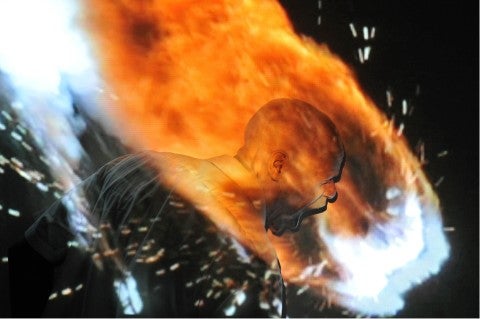Since Jefferson Pinder gained national attention with the exhibition Frequency at The Studio Museum in Harlem in 2006, he has created a series of video and performance works that explore the realities and emotional truths of Black lives through the physicality and expressiveness of the body. Pinder holds a BA in theater and an MFA in mixed media from the University of Maryland. He also studied at the Asolo Theatre Conservatory in Sarasota, Florida, and his background in the performing arts has significantly influenced his practice over the past twenty years. Pinder also draws inspiration from artists of color since the 1960s, who regarded the body as a site of representation and pushed the limits of their performances to comment on the social, cultural, and political conditions of their communities. As Pinder has stated, "I portray the Black body both frenetically and through drudgery in order to convey relevant cultural experiences."
Physical labor and strenuous activity serve as abstract metaphors in his work. For instance, performances by the breakdance crew The Lionz of Zion addressed police brutality following the killing of Michael Brown in Ferguson, Missouri, in Dark Matter (2014). In Mule (2006), Pinder dragged a three-hundred-pound log chained to his back through the streets of Baltimore, symbolizing the struggle and exhaustion experienced by Black populations in their efforts to achieve economic and political progress in the United States. For Passive/Resistance (2008), he evoked the social doctrines of nonviolent action espoused by Gandhi and Martin Luther King Jr. in a controversial video that features artist Matt Ravensthal, a White man, repeatedly slapping Pinder. As Pinder endures this confrontation, the power dynamics between the two men reflect America's racial history, prompting the viewer to feel a complex mix of shock, discomfort, amusement, anger, and sympathy.
In the same year as Passive/Resistance, Pinder created Afro-Cosmonaut/Alien (White Noise) (2008), a stop motion animation composed of more than two thousand photographs of individual poses. Drawing inspiration from post–World War II Japanese Butoh dance theater, Pinder begins by painting his entire head and neck white to match his shirt and the background, effectively transforming his body into a canvas to project upon. As his figure merges with a screen, he is overlaid with film reels. This footage includes the iconic NASA video of the U.S. rocket launch to the moon, as well as portrayals of space flight from films such as 2001: A Space Odyssey, The Right Stuff, Apollo 13, and Nicolas Roeg’s The Man Who Fell to Earth. The sparse soundtrack features Gil Scott-Heron’s 1970 track “Whitey on the Moon,” which critiques the divide between the United States’ displays of power during the space race and the stark realities faced by urban Americans. Dr. Martin Luther King Jr.’s “I’ve Been to the Mountaintop” speech also accompanies the imagery. The video culminates in a dramatic scene where Pinder’s body appears consumed by flames and explosions as he writhes with facial gestures of agony. The piece ends with him solemnly bowing his head amid a smoke-filled scene of destruction.
Pinder has said that inherent in this work is the notion of space as a realm where anything was possible, which he imagined during his youth. He recalls watching Star Trek, which featured the first interracial kiss on U.S. television—a groundbreaking historical event. This moment symbolized the fantasy of space as a place of infinite possibilities. However, his childhood optimism stands in stark contrast to the fear and uncertainty of life on Earth, as the Afro-Cosmonaut/Alien is engulfed by flames. Moreover, while Pinder’s video critiques past U.S. imperialistic showmanship, it also appears prescient. Today, as the wealthiest individuals in the country establish spacecraft corporations and compete to dominate space and colonize Mars, Afro-Cosmonaut/Alien raises critical questions about who will have the opportunity to participate in these ventures and what that participation will entail for those who lack money, power, and protection here on Earth. —Kanitra Fletcher

